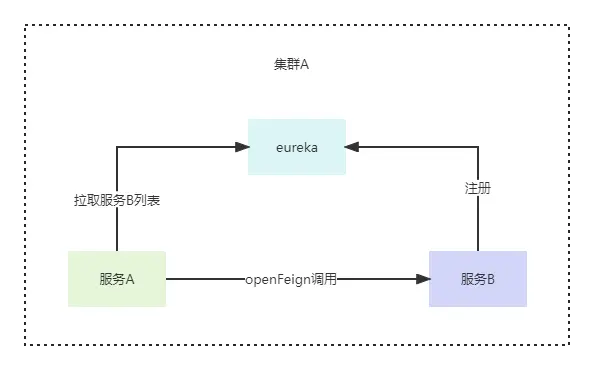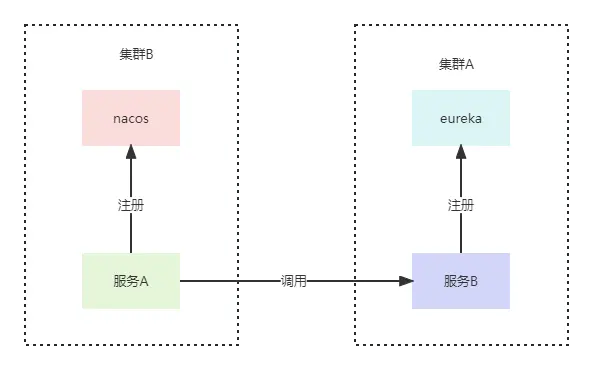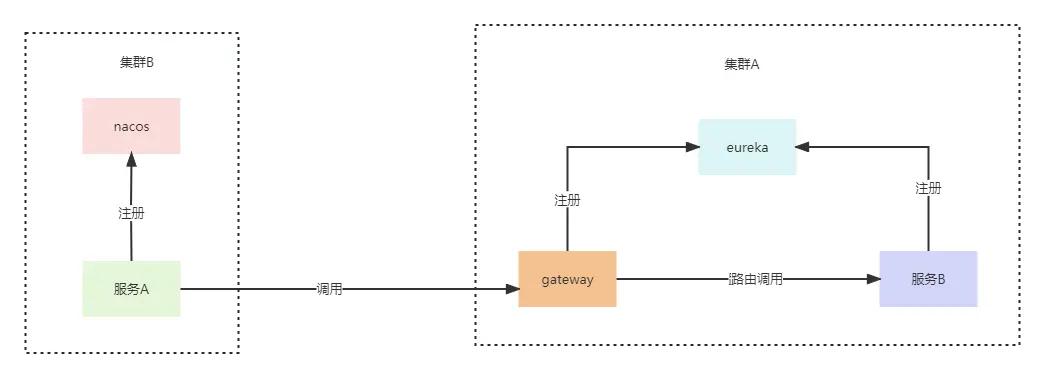聊聊不同集群的微服务如何通过feign调用
前言
之前业务部门的某项目微服务调用关系如下图
后因业务改造需要,该项目需要将服务A部署到另外一个集群,但服务A仍然需要能调用到服务B,调用关系如下图
之前调用方式是负责服务B的开发团队提供相应的feign客户端包给到服务A开发团队,服务A开发团队直接将客户端包引入到项目,在通过@EnableFeignClients来激活feign调用,现在跨了不同集群,而且2个集群间的注册中心也不一样,之前的调用方式就不大适用了。
业务部门的技术负责人就找到我们部门,看我们有没有什么方案。当时我们提供的方案,一种是服务A团队自己开发客户端接口去调用服务B,但这个方案工作量比较大。另外一种方案,就是通过改造openfeign。在业内一直很流行一句话,没有什么是加一层解决不了的
破局
后面我们提供的方案如下图
本质上就是原来服务A直接调用服务B,现在是服务A先通过和服务B同集群的网关,间接调用服务B。思路已经有了,但是我们需要实现业务能够少改代码,就能实现该需求
实现思路
通过feign的url + gateway开启基于服务注册中心自动服务路由功能
改造步骤
1、自定义注解EnableLybGeekFeignClients
@Retention(RetentionPolicy.RUNTIME)
@Target(ElementType.TYPE)
@Documented
@Import(LybGeekFeignClientsRegistrar.class)
public @interface EnableLybGeekFeignClients {
/**
* Alias for the {@link #basePackages()} attribute. Allows for more concise annotation
* declarations e.g.: {@code @ComponentScan("org.my.pkg")} instead of
* {@code @ComponentScan(basePackages="org.my.pkg")}.
* @return the array of 'basePackages'.
*/
String[] value() default {};
/**
* Base packages to scan for annotated components.
* <p>
* {@link #value()} is an alias for (and mutually exclusive with) this attribute.
* <p>
* Use {@link #basePackageClasses()} for a type-safe alternative to String-based
* package names.
* @return the array of 'basePackages'.
*/
String[] basePackages() default {};
/**
* Type-safe alternative to {@link #basePackages()} for specifying the packages to
* scan for annotated components. The package of each class specified will be scanned.
* <p>
* Consider creating a special no-op marker class or interface in each package that
* serves no purpose other than being referenced by this attribute.
* @return the array of 'basePackageClasses'.
*/
Class<?>[] basePackageClasses() default {};
/**
* A custom <code>@Configuration</code> for all feign clients. Can contain override
* <code>@Bean</code> definition for the pieces that make up the client, for instance
* {@link feign.codec.Decoder}, {@link feign.codec.Encoder}, {@link feign.Contract}.
*
* @return list of default configurations
*/
Class<?>[] defaultConfiguration() default {};
/**
* List of classes annotated with @FeignClient. If not empty, disables classpath
* scanning.
* @return list of FeignClient classes
*/
Class<?>[] clients() default {};
}
其实是照搬EnableFeignClients,差别只是import的bean不一样
2、扩展原生的FeignClientsRegistrar
扩展的核心内容如下
@SneakyThrows
private void registerFeignClient(BeanDefinitionRegistry registry,
AnnotationMetadata annotationMetadata, Map<String, Object> attributes) {
String className = annotationMetadata.getClassName();
Class feignClientFactoryBeanClz = ClassUtils.forName("org.springframework.cloud.openfeign.FeignClientFactoryBean",Thread.currentThread().getContextClassLoader());
String name = getName(attributes);
String customUrl = getCustomUrl(getUrl(attributes),name);
。。。省略其他代码
}
private String getCustomUrl(String url,String serviceName){
if(StringUtils.hasText(url)){
return url;
}
String gateWay = environment.getProperty("lybgeek.gateWayUrl");
if(StringUtils.isEmpty(gateWay)){
return url;
}
if(serviceName.startsWith("http://")){
serviceName = StrUtil.trim(serviceName.replace("http://",""));
}
String customUrl = URLUtil.normalize(gateWay + "/" + serviceName);
log.info("feign customed with new url:【{}】",customUrl);
return customUrl;
}
3、gateway开启基于服务注册中心自动服务路由功能
spring:
cloud:
gateway:
discovery:
locator:
enabled: true
lower-case-service-id: true
测试
测试提供一个消费者、服务提供者、网关、注册中心
在消费者的启动类去掉原生的EnableFeignClients注解,采用我们自定义注解EnableLybGeekFeignClients
@SpringBootApplication
@EnableLybGeekFeignClients(basePackages = "com.github.lybgeek")
public class ConsumerApplication {
public static void main(String[] args) {
SpringApplication.run(ConsumerApplication.class);
}
}
消费者application.yml开启feign调用日志
logging:
level:
# feign调用所在的包
com.github.lybgeek.api.feign: debug
feign:
client:
config:
default:
# 开启feign记录请求和响应的标题、正文和元数据
loggerLevel: FULL
通过消费端调用服务提供者
可以正常访问,我们观察消费者控制台输出的信息
我们可以发现,此次调用,是服务与服务之间的调用,说明我们扩展的feign保留了原本feign的能力
我们对消费者的application.yml,新增如下内容
lybgeek:
gateWayUrl: localhost:8000
再通过消费端调用服务提供者
可以正常访问,我们观察消费者控制台输出的信息
同时观察网关控制台输出的信息
我们可以发现,此次调用,是通过网关路由到服务再产生调用,说明我们扩展的feign已经具备通过网关请求服务的能力
总结
可能有朋友会说,何必这么麻烦扩展,直接通过
@FeignClient(name = "${feign.instance.svc:provider}",url="${lybgeek.gateWayUrl: }/${feign.instance.svc:provider}",path = InstanceServiceFeign.PATH,contextId = "instance")
不也可以实现。其实如果带入当时的业务场景考虑,就会发现这种方式,需要改的地方比直接扩展feign多得多,而且一旦出问题,不好集中回滚。有时候脱离业务场景,去谈论技术实现,会容易走偏
demo链接
共同学习,写下你的评论
评论加载中...
作者其他优质文章













